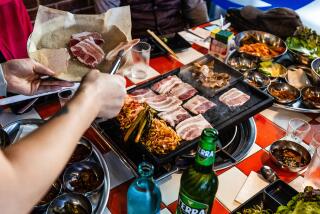A simmering mystery
- Share via
EVERY Sunday for several years when I was growing up in Manila, we’d pile into the family car and head out to our favorite Chinese noodle house for lunch.
We kids could order whatever we wanted, but somehow I always chose the same thing: a beef brisket noodle soup with each element of the dish in its own bowl. The clear broth was deliciously beefy and the fresh wheat noodles supple and al dente. But it was the brisket itself that I always polished off. The moist hunks, tender yet pleasantly chewy, were infused with exotic aromatic spices that I found irresistible. Dipping each bite into a bit of bright red chile sauce (there was a jar on every table) made it even better.
For the record:
12:00 a.m. Feb. 1, 2006 For The Record
Los Angeles Times Friday January 27, 2006 Home Edition Main News Part A Page 2 National Desk 0 inches; 18 words Type of Material: Correction
Brisket recipe -- A brisket recipe in Wednesday’s Food section omitted the number of servings, which is six.
For The Record
Los Angeles Times Wednesday February 01, 2006 Home Edition Food Part F Page 3 Features Desk 0 inches; 18 words Type of Material: Correction
Brisket recipe -- A brisket recipe in last week’s section omitted the number of servings, which is six.
My father, who knew the owner of the noodle shop, said that each of the chefs, who’d been brought in from Hong Kong, jealously guarded his culinary secrets. The dumpling chef, for one, would retreat to a corner in the kitchen to make the fillings, hunching over so prying eyes would not see his masterful proportions. Not that anyone was looking; each cook was in his own nook furtively concocting his specialty.
Knowing that raised the beef brisket in my esteem. After all, secret things happened in the kitchen to make it so good.
For decades afterward, I was content to leave that brisket as just a delicious memory. But as I grew into a cook myself, that memory returned more frequently -- and most persistently after chance encounters with what I came to realize was its signature spice: star anise. And so grew my hankering, and courage, to conjure up the dish in my kitchen.
It seemed such a daunting task, though, that I kept putting it off. But one day, I happened to ask my father if he remembered this brisket, and he surprised me by rattling off the requisite spices: fennel seeds, cumin seeds, cinnamon stick, dried orange peel, fresh ginger and of course, star anise. And don’t forget, he said, the rice wine, soy sauce and Chinese crystal rock sugar. I wanted to yell, “Why didn’t you ever tell me this?” But in fact, I had never asked. So instead I asked how he knew. “I used to do the purchasing for the restaurant when it first started,” he said, quite matter-of-factly.
I gathered the spices and went into the kitchen. I recalled helpful techniques from my father, an avid watcher of Chinese cooking shows. I consulted Chinese cookbooks.
What I found surprised and delighted me. It turns out that my favorite brisket, a so-called red-simmered or red-braised dish, is also a favorite at Chinese New Year celebrations. Red is the color of prosperity, so a red-braised brisket (meaning that it’s cooked in a reddish-brown sauce of spices and stock) symbolizes luck in the year ahead.
It’d be easy to take this dish for granted today. My grandmother, though, who lived in a poor rural area of Guangdong, could only dream of the dish. “They didn’t have the luxury of those spices,” my father said.
In a pinch, you could do without the cumin seeds or the cinnamon stick, but forget the star anise and this brisket will be a shadow of itself. It’s the one spice this dish cannot do without. And star anise makes red-braised brisket even luckier. Native to China, the spice has aromatic oils that are concentrated in its eight seeds, each held in one of its eight segments. Eight, to the Chinese, is the luckiest number of all.
It’s a lucky dish for the cook, too: It’s one of the easiest things to make for a party. Just blanch the beef, then leave it to simmer in a heady concoction of rice wine, soy sauce and spices. It can -- and ideally should -- be made ahead, whether it’s the day before or the morning of dinner. That way, after a couple of hours of braising, the brisket can steep in the fragrant cooking liquid and settle into a lovely state of tender chewiness. All the while, the flavors continue to meld.
It’s best made with the leaner half of the brisket, called the flat cut, rather than the more familiar -- and fattier -- point cut. (A whole brisket, which comes from the breast section under the first five ribs, is usually divided into these two cuts.)
These days, instead of serving noodles and soup with red-braised brisket, I steam or stir-fry some baby bok choy or nappa cabbage; the greens are a perfect foil to all that meaty succulence. And just as I did as a child, I reach for that jar of hot chile sauce.
But for real proof of red-braised brisket’s auspiciousness, consider that it is more long-sighted than you might think.
Save the braising sauce and your fortune is set: Your next brisket will be even better. All you need to do is use this mother sauce in place of some of the water and replenish it with spices. Do this every time and your brisket will be more flavorful than the last. How lucky is that?
**
Chinese beef brisket
Total time: 3 hours, plus optional cooling time
Note: Yellow rock sugar and dried tangerine peel are available at Asian grocery stores, usually in the spice aisle. The sugar is crystallized and often labeled “rock candy,” and the peel is labeled “citrus peel.” Or you may substitute 2 tablespoons granulated or light brown sugar for the rock sugar and dry your own tangerine peel. (To do so, carefully remove the peel from a tangerine, either in a spiral or in segments, keeping it in one piece if possible. Hang the peel on a clothesline or a hook for a few days until completely dry, ashy brown and stiff. Break off what you need and store the rest in a jar or plastic bag.) Do not use fresh peel for this recipe. Various Asian red chile sauces are available in the Asian food sections of supermarkets.
1 (3-pound) beef brisket (preferably the leaner flat cut rather than the fattier point cut)
1/2 cup rice wine
2/3 cup soy sauce
3 ounces yellow rock sugar (about 2 walnut-sized lumps)
1 (1 1/2 -inch) piece ginger, sliced
3 star anise
1/2 cinnamon stick
1 (2-inch) piece dried
tangerine peel
1 teaspoon cumin seeds
2 teaspoons fennel seeds
2 teaspoons cornstarch
(optional)
2 green onions, sliced
(optional)
Asian red chile sauce
(optional)
1. Choose a large pot or Dutch oven just wide enough to hold the beef brisket. Fill it with enough water to submerge the brisket. Bring the water to a boil. Carefully lower the brisket into the pot. Boil it for about 3 minutes (this gets rid of the impurities, which rise to the surface as foam).
2. Using tongs, carefully transfer the brisket to a colander and rinse it in cool water. Set aside. Discard the cooking water and rinse the pot.
3. In the pot, combine 6 cups water, the rice wine, soy sauce, rock sugar, ginger slices, star anise, cinnamon stick and dried tangerine peel. Bundle up the cumin and fennel seeds in a piece of cheesecloth and tie it shut with a piece of string. Add to the pot.
4. Cover the pot and bring the mixture to a boil. Lower the heat and carefully place the brisket in the liquid. If necessary, add more water to ensure that the brisket is covered. Return to a boil, then simmer for about 2 hours, until fork-tender.
5. Remove from the heat, uncover and allow to cool. Remove the spices, then refrigerate the brisket overnight to allow the flavors to meld. (If serving immediately, proceed to the next step.)
6. Transfer the brisket to a cutting board and cut into one-third-inch slices. If the brisket was cooled or refrigerated, place the pieces in a large saucepan and ladle in just enough of the braising liquid to cover. Warm over medium heat until heated through.
7. Remove the meat with a slotted spoon or tongs, and arrange the pieces on a serving platter. Pour a little of the liquid over the beef. If you want a thicker sauce, cover the beef with foil to keep warm. In a cup, combine the cornstarch with 2 tablespoons water. Bring 1 cup of the braising liquid to a boil and add the cornstarch mixture, cooking and stirring until thickened, about 1 minute. Pour the sauce over the beef. Garnish with sliced green onions, if desired, and serve with red chile sauce.
8. Save the remaining braising liquid. Strain into an airtight container and refrigerate for up to 3 days, or freeze. Discard any congealed fat on the surface. The next time you make brisket, use this liquid in place of some of the 6 cups of water. Add more water to cover the meat and toss in a new batch of rice wine, soy sauce and spices.
Each serving: 290 calories; 38 grams protein; 13 grams carbohydrates; 0 fiber; 7 grams fat; 3 grams saturated fat; 72 mg. cholesterol; 1,404 mg. sodium


